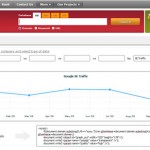Despite our best predictions with SEO, you can never pin-point with accuracy which keywords from a title tag, meta description or combined occurrence of a keyword on a page search engines will use to return a relevant query.
This is why it is imperative to promote as many relevant shingles as possible for returning a page as a relevant hit for a “specific” or “broad match” search queries through using succinct titles, naming conventions or meta descriptions.
We can create all of the multiple layers in advance, but each metric will be scrutinized for trust, depth and popularity and authority, and depending on how it fares from these algorithmic litmus tests determines what degree of visibility the page receives.
Typically one of two things occurs (1) it flies to the top 10 unchallenged, feels its way out and is assessed by metric such as click-throughs and relevance (sort of like a test to see if it belongs there) or (2) the ranking crawls its way up over time and in a few months finds its home in the top 10 if combined with other pages via internal linking or get a few deep links from other pages.
What I can tell you is that the signals gleaned from (a) the volume of content in your site about each of the topics / keywords in the title and (b) how well they are linked together or have an influx of deep links do affect the buoyancy of any related page.
Both phases (the initial spike) and the buoyant balloon effect should be predicted and anticipated.
Depending on the barrier to entry (how much competition is saturating the keywords in question) will determine just how much traction a new page gets out of the gate.
Much like a wave form, there is often a burst of SERP (search engine result page) positioning that occurs as the new page/content acts like a beacon to release the pressure of relevance that percolates under the surface.
It is like a concentrated topical fulcrum that serves to propel the newly released content into a favorable trajectory and then based on search volume, click-appeal and what other pages are challenging that page for relevant supremacy determine the extent of its exposure.
The more competitive the root or key phrase, the longer it typically takes to reach the top of a more competitive keyword combination.
Although a page can rank for multiple variations (depending on the authority of the root domain), it is better to assign a pecking order to the page to emphasize which keywords you would like it to be found for or settling into as the primary path for relevant traffic.
For example, if I create a new page and use a relevant title and meta description such as:
SEO Business Consulting Services
Business consulting services by “company x”, provides SEO [keyword 1], service [keyword 2], and summary [plural usage of alternative keywords combined]…
This page could rank for any portion of any of the relevant keywords contained/presented in this crucial / summary.
This is your first line of coherence for each page, structure this well and you can ensure that search engines take heed and will often use this as the default snippet/description to promote click-throughs from interested parties.
The description tag should always support the title, ( a slight bit of redundancy/relevance) doesn’t hurt, but it should also contain your secondary keyword or a few alternatives as well to promote “cross pollination” of keywords which occurs naturally when a page gains age, support from other pages (via internal or external links).
A degree of transference is anticipated, so, the meta description allows you to steer that process into a conversion objective by sculpting the aggregate ranking factors and giving them stability as a heading for search engines to adhere.
Going back to the example above and filling in the blanks for the sake of continuity:
SEO Business Consulting Services
Business consulting services by “marketing solutions”, provides SEO, landing page optimization, internal link optimization and link building services for search engine optimization.
If you then had headings on the page for the topics mentioned:
SEO, Landing Page Optimization, Internal Link Optimization and Link Building Services then this page would be a self fulfilling prophecy and rank across any keyword combination over time.
For example, search engine queries such as:
Landing Page Consulting
Search Engine Optimization Consulting
Business Optimization Services
Landing Page Optimization
Internal Link Optimization
Business Consulting Services
Would all be “a relevant hit” as part of the root phrases/shingles implied by the title and meta descriptions.
If you add enough internal links from any of the keyword combinations above from other pages (that already have relevance for those keywords) and you will create a dynamo of keyword stemming that can pass along ranking factor to the new target page.
For example 10 links internally from the keyword “Search Engine Optimization Consulting” from a page that ranks already for some shingle in the keyword combined with 15 deep links (links from other sites) would provide enough transference to put this page on the map for that keyword.
If it appears in the top 100 from not in the top 1000, then you know you have crossed the tipping point for some of the most crucial metrics.
From there, you need to (1) reinforce it over time with additional internal or external links and (2) give it enough time to stem and settle into its purpose as a designated landing page and gain on page authority.
In other words, a page can rank from 1 or two words on the target page, if (a) there is enough internal links to support the transference of link weight and authority and (2) if the page is groomed as a relevant candidate from the continuity between the content, title and reputation that page has within the hierarchy of your website.










Thanks for the great article. Website bookmarked ;)
Thanks For You Sharing this content more be advantages for me :)